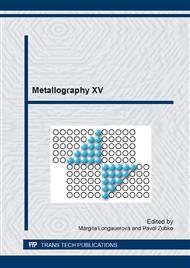[1]
O. Bouaziz, S. Allain, C.P. Scott, P. Cugy, D. Barbier, High manganese austenitic twinning induced plasticity steels: A review of the microstructure properties relationships, Current Opinion in Solid State and Materials Science, 15 (4) (2011).
DOI: 10.1016/j.cossms.2011.04.002
Google Scholar
[2]
P. La, F. Wei, S. Hu, C. Li, Y. Wei, White cast iron with a nano-eutectic microstructure and high tensile strength and considerable ductility prepared by an aluminothermic reaction casting, Materials Science and Engineering A, 561 (2013) 317-320.
DOI: 10.1016/j.msea.2012.10.002
Google Scholar
[3]
M. Kawalec, E. Fraś, Structure, mechanical properties and wear resistance of high-vanadium cast iron, ISIJ International, 48 (4) (2008) 518-524.
DOI: 10.2355/isijinternational.48.518
Google Scholar
[4]
D.B. Miracle, Metal matrix composites - From science to technological significance, Composites Science and Technology, 65 (2005) 2526-2540.
DOI: 10.1016/j.compscitech.2005.05.027
Google Scholar
[5]
C. Krüger, A. Mortensen, Al2O3 particle rounding in molten copper and Cu8wt%Al, Journal of Materials Science, 47 (2012) 6346-6353.
DOI: 10.1007/s10853-012-6559-z
Google Scholar
[6]
A. Janas, A. Kolbus, E. Olejnik, On the character of matrix-reinforcing particle phase boundaries in MeC and MeB (Me = W, Zr, Ti, Nb, Ta) in-situ composites, Archives of Metallurgy and Materials, 54 (2) (2009) 319-327.
Google Scholar
[7]
P. Kurtyka, N. Ryłko, Structure analysis of the modified cast metal matrix composites by use of the RVE theory, Archives of Metallurgy and Materials, 58 (2) (2013) 357-360.
DOI: 10.2478/v10172-012-0198-x
Google Scholar
[8]
A.G. Merzhanov, A new processing for the self-propagating high- temperature, Journal of Materials Processing Technology, 56 (1996) 222-241.
Google Scholar
[9]
M. Cholewa, T. Wróbel, S. Tenerowicz, T. Szuter, Diffusion phenomena between alloy steel and gray cast iron in layered bimetallic casting, Archives of Metallurgy and Materials, 55 (3) (2010) 771-777.
Google Scholar
[10]
J. Przybyłowicz, J. Kusiński, Structure of laser cladded tungsten carbide composite coatings, Journal of Materials Processing Technology, 109 (1-2) (2001) 154-160.
DOI: 10.1016/s0924-0136(00)00790-1
Google Scholar
[11]
K. Asano, H. Yoneda, Formation of in situ composite layer on magnesium alloy surface by casting process, Materials Transactions, 49 (10) (2008) 2394-2398.
DOI: 10.2320/matertrans.mer2008198
Google Scholar
[12]
E. Olejnik, M. Górny, T. Tokarski, B. Grabowska, A. Kmita, G. Sikora, Composite zones produced in iron castings by in-situ synthesis of TiC carbides, Archives of Metallurgy and Materials, 58 (2) (2013) 465-471.
DOI: 10.2478/amm-2013-0019
Google Scholar
[13]
L. Niu, M. Hojamberdiev, Y. Xu, Preparation of in situ-formed WC/Fe composite on gray cast iron substrate by acentrifugal casting process, Journal of Materials Processing Technology, 210 (2010) 1986-(1990).
DOI: 10.1016/j.jmatprotec.2010.07.013
Google Scholar


